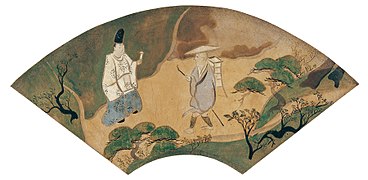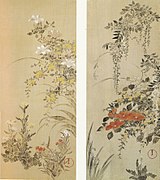Fukae Roshu
Fukae Roshū ( Japanese 深 江 蘆 舟 , real name: Fukae Shōroku (深 江 庄 六); born 1699 in Kyoto ; died May 25, 1757 ) was a Japanese painter of the Rimpa direction of the middle Edo period .
life and work
Fukae Roshū was born the eldest son of Fukae Shōzaemon (深 江 庄 左衛 門), an employee who worked for the state mint. Fukae is, next to Watanabe Shikō , the most important student of Ogata Kōrin , who was also closely related to the coin. Fukae worked in the Kōrin style, but his pictures show a simpler decorative style that is more reminiscent of the time before Kōrin, of Tawaraya Sōtatsu . - Fukae died at the age of 58, he was buried in the Saiun-in (西 雲 院), a sub-temple of Konkaikōmyō-ji (金 戒 光明 寺) in Kyoto.
His best-known works are the screen "蔦 細 道 図 屏風" (Tsuta hosomichi to byōbu, Narrow Way and Ivy) measuring 132.4 × 264.4 cm in the Tokyo National Museum ( important cultural asset of Japan ), the very similar screen in the Cleveland Museum of Art and the screen "草花 図 屏風" (Sōka to byōbu, grasses and flowers), formerly in the Kyūkyodō collection.
photos
- ↑ Two of six hanging scrolls, originally two parts of a six-part screen. Owned by the Freer Gallery of Art .
Remarks
- ↑ There is a pair of screen pairs of the same name from Tawaraya Sōtatsu.
literature
- Tazawa, Yutaka: Fukae Roshū . In: Biographical Dictionary of Japanese Art. Kodansha International, 1981. ISBN 0-87011-488-3 .
- Laurance P. Roberts: Fukae Roshū . In: A Dictionary of Japanese Artists. Weatherhill, 1976. ISBN 0-8348-0113-2 .
Web links
| personal data | |
|---|---|
| SURNAME | Fukae, Roshu |
| ALTERNATIVE NAMES | 深 江 蘆 舟 (Japanese); Fukae Shōroku (real name); 深 江 庄 六 (real name, Japanese) |
| BRIEF DESCRIPTION | Japanese painter |
| DATE OF BIRTH | 1699 |
| PLACE OF BIRTH | Kyoto |
| DATE OF DEATH | May 25, 1757 |



